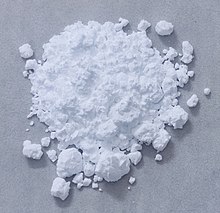Lutetium(III) oxide
 | |
| Names | |
|---|---|
| Other names
Lutetium oxide, Lutetium sesquioxide
| |
| Identifiers | |
3D model (
JSmol ) |
|
| ChemSpider | |
ECHA InfoCard
|
100.031.591 |
| EC Number |
|
PubChem CID
|
|
CompTox Dashboard (EPA)
|
|
| |
SMILES
| |
| Properties | |
| Lu2O3 | |
| Molar mass | 397.932 g/mol |
| Melting point | 2,490 °C (4,510 °F; 2,760 K) |
| Boiling point | 3,980 °C (7,200 °F; 4,250 K) |
| Solubility in other solvents | Insoluble |
| Band gap | 5.5 eV[1] |
| Structure | |
| Bixbyite | |
| Ia3 (No. 206) | |
| Related compounds | |
Other anions
|
Lutetium(III) chloride |
Other cations
|
Scandium(III) oxide Yttrium(III) oxide |
| Supplementary data page | |
| Lutetium(III) oxide (data page) | |
Except where otherwise noted, data are given for materials in their standard state (at 25 °C [77 °F], 100 kPa).
| |
Lutetium(III) oxide, a white solid, is a
History
In 1879, Swiss chemist Jean Charles Galissard de Marignac (1817–1894) claimed to have discovered ytterbium, but he had found a mixture of elements. In 1907, French chemist Georges Urbain (1872–1938) reported that ytterbium was a mixture of two new elements and was not a single element. Two other chemists, Carl Auer von Welsbach (1858–1929) and Charles James (1880–1926) also extracted lutetium(III) oxide around the same time. All three scientists successfully separated Marignac's ytterbia into oxides of two elements which were eventually named ytterbium and lutetium). None of these chemists were able to isolate pure lutetium. James' separation was of very high quality, but Urbain and Auer von Welsbach published before him.[5][6]
Uses
Lutetium(III) oxide is an important raw material for laser crystals.[7] It also has specialized uses in ceramics, glass, phosphors, and lasers. Lutetium(III) oxide is used as a catalyst in cracking, alkylation, hydrogenation, and polymerization.[2] The band gap of lutetium oxide is 5.5 eV.[1]
References
- ^ S2CID 101643906.
- ^ a b Lutetium Oxide. 1997-2007. Metall Rare Earth Limited. http://www.metall.com.cn/luo.htm
- ^ Macintyre, J. E. (1992). Dictionary of Inorganic Compounds Volumes 1–3. London: Chapman & Hall.
- ^ Trotman-Dickenson, A. F. (1973). Comprehensive Inorganic Chemistry. Oxford: Pergamon.
- ^ "Separation of Rare Earth Elements by Charles James". National Historic Chemical Landmarks. American Chemical Society. Retrieved 2014-02-21.
- ^ Weeks, Mary Elvira (1956). The discovery of the elements (6th ed.). Easton, PA: Journal of Chemical Education.
- PMID 26698962.
